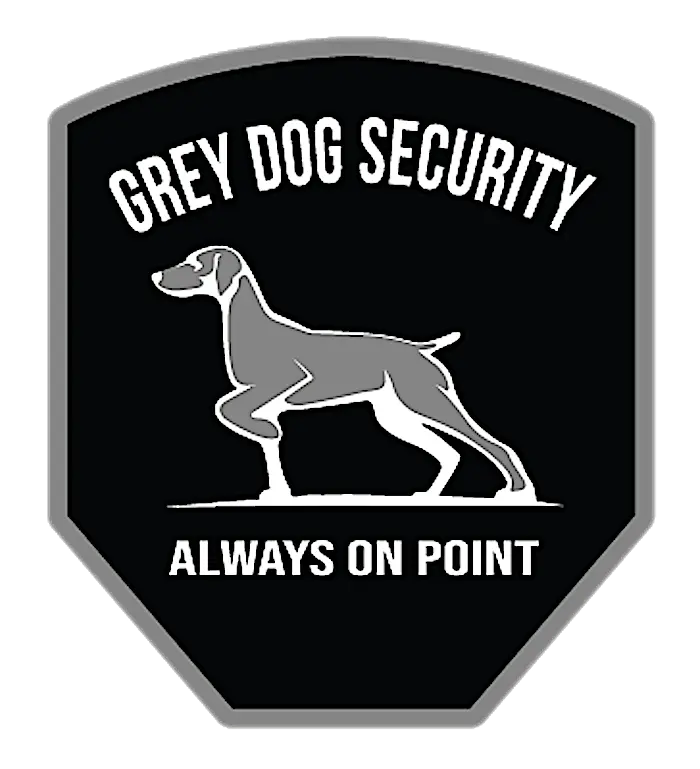Verbal De-escalation in Private Security: Preventing Conflict Before It Escalates
Grey Dog Security
Author
Effective conflict resolution is crucial for security personnel. De-escalation techniques are essential in preventing situations from turning into physical confrontations, allowing security professionals to manage tense situations safely and maintain control.
Security guards are often the first line of defense in potential conflicts. Their ability to handle these situations can mean the difference between a peaceful resolution and unnecessary escalation. Verbal de-escalation, in particular, is a critical tool that allows security personnel to manage conflicts with confidence, minimizing the need for physical force and ensuring a controlled environment.
Research in related fields, such as law enforcement, demonstrates the positive impact of de-escalation training. Programs like Integrating Communications, Assessment, and Tactics (ICAT) have been associated with a more than 25% reduction in officer use of force and civilian injuries.
Additionally, other de-escalation initiatives have led to a 28% reduction in use-of-force incidents and a 36% decrease in officer injuries. These findings suggest that similar training could significantly benefit security personnel, helping to reduce physical confrontations and improve overall safety.
Role of Verbal De-escalation in Security
The most effective security professionals are not those who win confrontations, but those who prevent them entirely. Security officers play a vital role in ensuring public safety. Their ability to respond appropriately to conflicts without resorting to physical force is essential in modern security services.
Aspects of Effective Security Response:
- Recognizing Warning Signs: Some individuals may exhibit early signs of aggression. Security officers must be trained to identify these signs and intervene before tensions escalate.
- Effective Communication: Successful conflict resolution hinges on communication. Using non-verbal cues, controlled speech, and body language can prevent confrontations from intensifying.
Verbal de-escalation is both an art and a science, rooted in psychology, communication theory, and practical experience. It involves using controlled communication techniques to calm aggressive individuals and guide them toward a peaceful resolution. It is not just about what is said but also how it is said, including tone, pacing, and body language.
The goal is to create a structured approach to handling conflicts, allowing security personnel to maintain order without escalating tension. A well-skilled security officer can identify warning signs of agitation early and intervene with de-escalation strategies before emotions spiral out of control.
Prioritizing dialogue over dominance enables security personnel to resolve tensions while preserving dignity, minimizing risk, and fostering trust. This trifecta of outcomes benefits individuals, organizations, and communities alike.
5 Principles of De-escalation for Security Personnel

Security personnel must be aware of these guiding principles when handling tense situations:
1. Maintaining Composure
Security professionals must control their own emotions before they can calm another person. A security officer who remains calm sets the tone for a peaceful resolution. If a security professional reacts aggressively, it can escalate the conflict further.
2. Understanding Triggers
Recognizing what causes an individual to become agitated is key to preventing escalation. Some people may react negatively to authoritative commands, while others may become more cooperative if they feel heard and understood.
3. Offering Choices and Solutions
Instead of issuing direct commands, providing options can help an individual feel in control of the situation, reducing their need to resist authority.
4. Being Patient and Allowing Space
Pressuring an already distressed individual can worsen the situation. Giving the person time to calm down and space to process their emotions can be an effective way to reduce hostility.
5. Using Empathy and Understanding
Acknowledging the concerns of an agitated individual and validating their emotions can help in executing de-escalation strategies more effectively.
Sometimes, a simple, “I understand why you’re upset,” can make a difference.
5 Critical Communication Techniques for De-escalation

Security personnel must use precise communication tactics to ensure effective de-escalation training. The following methods help in controlling situations before they become uncontrollable:
1. Active Listening
This involves demonstrating understanding by paraphrasing the individual's concerns.
For instance, saying, "I hear that you’re upset about this situation; let’s work on resolving it," can significantly reduce hostility. Mirroring and paraphrasing show empathy and acknowledge emotions, preventing an angry person from feeling dismissed.
2. Mirroring and Paraphrasing
Reflecting on the other person’s statements to them shows empathy and acknowledges their emotions. This can prevent an angry person from feeling dismissed.
3. Using Open-Ended Questions
Encouraging dialogue instead of confrontation helps guide conversations toward solutions rather than conflict.
Asking, "How can we resolve this together?" fosters cooperation and encourages both parties to work toward a mutually beneficial outcome.
4. Maintaining a Steady Tone
Speaking in a calm, controlled manner reassures individuals and prevents further agitation. Raising one's voice can be perceived as aggression and should be avoided.
5. Recognizing Non-Verbal Cues
An agitated individual may exhibit signs of discomfort or aggression through their body movements. Reading these signals allows security officers to respond appropriately and adjust their approach accordingly.
The Impact of Body Language on Conflict Resolution

Verbal communication is only part of the equation when it comes to de-escalation. Body language plays a significant role in how messages are received and can either calm or escalate a situation. Security personnel must be mindful of their non-verbal cues to maintain a non-threatening presence.
A security officer who masters body language can often de-escalate conflicts without needing to say much. When combined with verbal techniques, it creates a smooth approach to conflict resolution.
1. Open Posture
Crossing arms, clenching fists, or standing too rigidly can appear confrontational. Keeping an open stance with relaxed hands signals a willingness to communicate.
2. Controlled Gestures
Sudden movements or pointing fingers can be perceived as aggression. Slow and deliberate gestures indicate calmness and control.
3. Eye Contact
Maintaining steady but non-intimidating eye contact reassures individuals that they are being listened to while avoiding an aggressive stare that may provoke hostility.
4. Physical Space
Standing too close can make an individual feel threatened, while standing too far may seem dismissive. Keeping a balanced distance allows for a more comfortable interaction.
5. Facial Expressions
A neutral, relaxed face conveys calmness. Raised eyebrows, frowning, or looking disinterested can make the other person feel more agitated.
3 Common Scenarios and How Security Guards Execute De-escalation Strategies
Security guards encounter various situations requiring de-escalation techniques. Each scenario presents unique challenges, but applying the right approach can prevent conflicts from escalating.
1. Managing an Aggressive Individual

An angry person may react unpredictably, requiring private security officers to assess warning signs early.
Security personnel should maintain a safe distance, use de-escalation techniques such as controlled speech, and engage in active listening to defuse the tension. Avoiding confrontation and instead offering solutions can redirect aggression into cooperation.
2. Dealing with an Intoxicated Person
When managing an intoxicated individual, security officers should prioritize maintaining a calm demeanor and speaking clearly. It's crucial to guide the person toward a safer space without provoking them. Avoid confrontational language or actions, as these can exacerbate the situation.
Instead, focus on providing a supportive and non-threatening environment that encourages cooperation. This approach not only ensures the safety of the individual but also helps prevent unnecessary escalations that could lead to legal or reputational issues.
3. Handling Disputes in High-Traffic Areas
Crowded environments increase the likelihood of conflicts. Security guards can facilitate resolution by using de-escalation training to guide individuals to a quieter area, reducing external stimuli that may fuel aggression. Keeping a neutral stance while offering assistance can prevent the dispute from spreading or involving bystanders.
5 Mistakes to Avoid During De-escalation Attempts
Even with proper training, security personnel can make mistakes that inadvertently escalate a situation rather than diffuse it. Understanding what not to do is just as important as knowing what to do when practicing de-escalation techniques.
A calm, patient approach always yields better results. Here are some common errors to avoid:
1. Raising Your Voice
Shouting or speaking in an authoritative tone can come across as aggressive, increasing hostility rather than diffusing it.
2. Ignoring the Individual’s Emotions
Dismissing concerns or refusing to acknowledge an individual’s frustrations can lead to greater resistance.
3. Failing to Read Non-Verbal Cues
If someone is clenching their fists, pacing, or breathing heavily, these are warning signs that they may be on the verge of becoming physically aggressive. Ignoring these signs can be dangerous.
4. Using Force Prematurely
Resorting to physical force too quickly can escalate the conflict into a potentially dangerous situation rather than resolving it peacefully.
5. Not Allowing the Individual to Speak
Interrupting or talking over someone can make them feel disrespected and increase their aggression. Listening actively helps in guiding the conversation toward a resolution.
How Grey Dog Security Sets the Standard in Verbal De-escalation?

At Grey Dog Security, we believe that effective security goes beyond mere presence—it involves intelligence, professionalism, and, most importantly, a proactive commitment to conflict resolution.
Our team excels in managing tense situations with finesse, using proven de-escalation techniques to prevent conflicts before they start. We recognize that safety isn’t just about handling the immediate threat, but preventing it from occurring altogether.
Leading the Way in Conflict Prevention
Serving industries ranging from corporate offices to high-profile events and private protection, Grey Dog Security stands out for its emphasis on strategic conflict prevention. We pride ourselves on our ability to apply tailored de-escalation strategies that prioritize the well-being of clients, employees, and the public.
Whether it’s at a large-scale event or in a corporate setting, we ensure that our security personnel handle each scenario with care, focus, and the professionalism that sets us apart as the leading security service provider in West Michigan.
Our Approach:
Situational Awareness
Our security professionals are trained to spot early warning signs and intervene before a situation escalates. Through constant vigilance and assessment, we reduce the risk of confrontation, ensuring everyone’s safety.
Tailored Security Solutions
We understand that every security environment is unique, which is why we customize our approach for each client. From adjusting our de-escalation tactics to meet the specific needs of a business or event, to ensuring our team adapts to the dynamics of different locations, we deliver the most effective conflict resolution strategies for every situation.
Professionalism and Expertise
Grey Dog Security is proud to employ only the most experienced and highly skilled security personnel. Our commitment to verbal de-escalation is central to our security philosophy, ensuring that safety is always handled with respect, care, and the highest standards of professionalism.
Why Grey Dog Security?
As the trusted security partner of choice in West Michigan, Grey Dog Security’s reputation is built on the success of our de-escalation strategies, which allow us to maintain safe environments with minimal disruption.
When you choose us, you're not just securing your business or event—you’re choosing a security team that values smart, effective conflict resolution that strengthens the safety of everyone involved. Our ability to diffuse tense situations and keep people safe without resorting to unnecessary force is what truly sets us apart in the security industry.
To learn more about our professional security guarding services and how we can customize a solution that fits your unique needs, contact us at 1-800-903-4110 or email info@greydogsecurity.com.
Let’s start building a safer environment together.
Conclusion
De-escalation stands as a cornerstone of professional security practice, transforming potential conflicts into opportunities for constructive resolution.
The techniques outlined here—rooted in psychological principles and practical communication strategies—equip security personnel with tools to navigate tense situations effectively. When implemented with skill and professionalism, these methods not only prevent escalation but also build trust, enhance safety, and uphold the dignity of all involved.
The true value of de-escalation extends beyond immediate conflict resolution. Organizations that prioritize this training cultivate security teams capable of handling complex interactions with confidence and composure.
In doing so, they set a higher standard for the industry—one where security professionals serve as mediators and problem-solvers, not just enforcers.
As expectations for ethical and effective security services continue to rise, mastery of de-escalation techniques will remain an essential measure of excellence in the field. The result is safer environments, stronger community relationships, and a more respected profession overall.
Frequently Asked Questions
1. What is verbal de-escalation, and why is it important in private security?
Verbal de-escalation is the use of communication techniques to defuse tense situations and prevent conflicts from escalating. It is essential in private security because it allows security personnel to manage potentially dangerous situations without resorting to physical force, ensuring a safe and controlled environment.
2. How do security guards recognize when a situation requires de-escalation?
Skilled security officers identify warning signs such as aggressive body language, raised voices, clenched fists, pacing, or hostile verbal threats. Recognizing these early indicators allows security professionals to respond appropriately before the situation worsens.
3. What are the key components of effective de-escalation techniques?
Successful de-escalation strategies involve controlled body language, active listening, maintaining a calm voice, offering choices rather than commands, and showing empathy to defuse hostility. The ability to execute de-escalation strategies effectively can prevent conflicts from escalating.
4. How does body language impact de-escalation efforts?
Body language plays a critical role in how security professionals communicate with an agitated individual. An open posture, steady (but non-threatening) eye contact, relaxed hands, and a neutral facial expression signal calmness and control, helping to ease tension and reduce aggression.
5. When should a security officer switch from de-escalation to a different approach?
In the event that an individual demonstrates violent tendencies or continues to refuse compliance following repeated de-escalation efforts, security officers may be required to implement alternative procedures, such as summoning reinforcements or engaging law enforcement. The preservation of safety for all individuals involved is the foremost concern.
6. How does Grey Dog Security implement de-escalation strategies in its services?
At Grey Dog Security, our private security officers are skilled in advanced de-escalation techniques to manage tense situations with professionalism. Our team emphasizes situational awareness, early conflict intervention, and customized de-escalation methods to ensure the best outcomes for our clients.
© 2025 Grey Dog Security. All Rights Reserved.
Designed and Powered by WebriQ.



